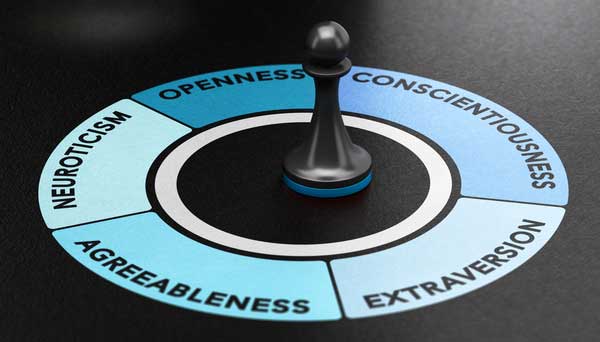The “Big Five” is a well-researched model for conceptualizing personality traits. In this model, there are five key dimensions of personality that account for most individual differences in personalities. These five traits provide a useful framework for understanding ourselves and the people around us. This article will explore the Big Five traits in-depth.

What Are the Big Five Personality Traits?
The five traits that make up the Big Five model are:
- Openness to Experience
- Conscientiousness
- Extraversion
- Agreeableness
- Neuroticism
You can remember the traits using the acronym OCEAN. Let’s look at each of these traits more closely.
Openness to Experience
Openness to experience refers to a person’s willingness to try new things and be open to new ideas. People who score high in openness tend to be intellectually curious, open-minded, imaginative, and insightful.
Characteristics of people with high openness include:
- Appreciation for art, emotion, adventure, unusual ideas, creativity, and variety of experience
- Flexible thinking patterns
- Tendency to come up with creative ideas
- Willingness to question authority and traditional values
- Preference for variety over routine
People low in openness tend to be more conventional and traditional in their beliefs. They prefer familiarity over novelty and follow established methods.
Research shows that openness correlates positively with overall intelligence. People high in openness also tend to pursue more years of education.
Conscientiousness
Conscientiousness reflects a person’s ability to exercise self-control and willingness to follow socially prescribed rules. Highly conscientious people are organized, reliable, productive, and purposeful.
Characteristics of highly conscientious people include:
- Strong organizational skills and attention to detail
- Tendency to be reliable, prompt, and diligent
- Inclination to think carefully before acting
- Enjoyment of planning events ahead of time
- Dislike of last-minute preparations and messy environments
People on the low end of conscientiousness are less driven, more lackadaisical, and less focused on productivity. They are also more likely to procrastinate and act impulsively without planning ahead.
Extraversion
The extraversion trait governs a person’s inclination to seek stimulation from others and their external environment. Introverts, on the other hand, tend to be inwardly focused, less social, and require less stimulation.
Characteristics of extroverts include:
- Deriving energy from social gatherings and activities
- Enjoyment of meeting new people and trying new activities
- Tendency to be enthusiastic, talkative, and assertive
- Comfort being the center of attention
- Having many acquaintances but fewer intimate friends
Introverts tend to have less energy for highly stimulating social situations. They favor solitary activities and have just a few close friendships. Introverts also think before they speak and dislike small talk.
Agreeableness
Agreeableness reflects a person’s attitudes toward harmony and cooperation. Highly agreeable people value getting along well with others. They are friendly, considerate, kind, generous, and willing to compromise.
Characteristics of highly agreeable people include:
- Tendency to be polite, modest, and cooperative
- Inclination to trust people and adopt their perspectives
- Empathetic nature and concern for social harmony
- Willingness to help others and avoid conflict
Disagreeable people place self-interest above getting along with others. They are generally less concerned about harmony in groups or relationships. Disagreeableness also correlates with competitiveness and skepticism about others’ intentions.
Neuroticism
Neuroticism measures a person’s tendency to experience negative emotions. People high in neuroticism frequently feel nervous, anxious, sad, tense, worried, angry, frustrated, guilty, embarrassed or insecure. They have trouble managing stress and often interpret ordinary situations as threatening.
Characteristics of people high in neuroticism include:
- Difficulty managing stress levels and regulating emotions
- Tendency to worry excessively and feel insecure or inadequate
- Inclination to feel irritable, anxious, or depressed
- Sensitivity to perceived threats and criticisms from others
People with low neuroticism scores experience less frequent and intense negative emotions. They tend to seem calmer, more emotionally stable, and less reactive to stress.
Where Do These Traits Come From?
Research suggests personality traits have both genetic and environmental influences. Genetics are believed to explain around 50% of personality variation between people. The heritability estimates are higher for openness (59%) and lower for agreeableness (42%) and neuroticism (48%).
Childhood experiences, culture, significant life events, and other environmental factors account for the remaining differences in personalities. However, research shows personality traits tend to remain fairly stable in adulthood. So even as our circumstances change, the core aspects of our personalities stay consistent.
Key Takeaways
- The Big Five model proposes five key personality traits that can account for individual differences in personalities: openness, conscientiousness, extraversion, agreeableness, and neuroticism.
- Genetics explain around half of personality variation between people, with the rest coming from environmental influences.
- Personality traits tend to be relatively stable through adulthood, even as life circumstances change.
- No traits are inherently “good” or “bad” – each has advantages and disadvantages depending on the context.
Understanding someone’s place on these five trait dimensions provides insight into their typical thoughts, feelings and behaviors. The Big Five model gives us a consistent framework for conceptualizing personalities in all their complexity.
I hope this overview has provided a helpful introduction to this influential theory on the structure of personality traits. Let me know if you have any other questions!
